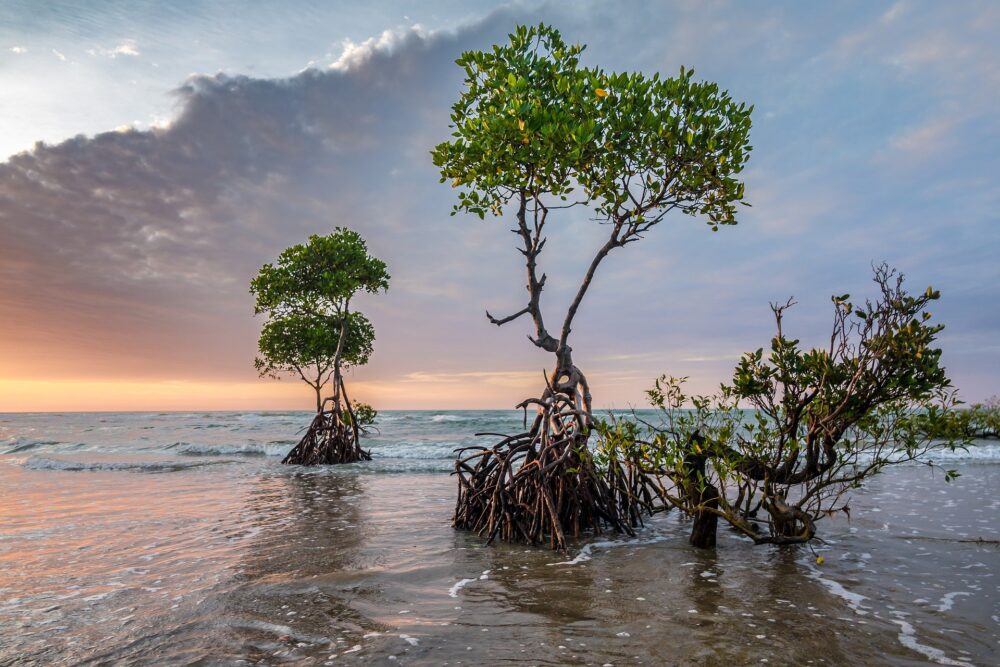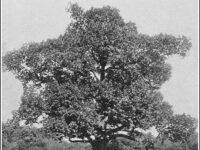Globally, Indonesia hosts the largest concentration of mangrove forests, accounting for over 20% of the world’s total mangrove population. According to the United Nations Food and Agriculture Organization, mangrove forests are among the most threatened ecosystems on our planet, with Indonesia reporting the greatest decline in population of any concentrated area of mangrove forest. Without intervention, the ongoing loss of mangrove forests may create a feedback loop in which stored carbon dioxide, absorbed from the atmosphere as trees grow, is released, driving further global warming and an increase in the occurrence of natural disasters. Such natural disasters have the potential to exacerbate damage to the already feeble coastal communities of Indonesia in the absence of the buffer that mangrove forests provide.
Mangrove trees are ecosystem engineers, maintaining and manipulating the ecosystem around them. The dense roots of mangrove trees serve to bind coastal soils and slow tide flows before they reach the shoreline, preventing coastal abrasion and tidal flooding. Furthermore, coastal Indonesians rely heavily on the ecosystem services that these forests provide. Among locals, mangrove forests remain a source of economic and cultural security, with many families relying on the trees for direct benefits such as food, medicine, and lumber as well as indirect benefits such as tourism and cultural heritage. One of the biggest threats to coastal Indonesian communities is coastal degradation, which facilitates both erosion and tidal flooding of the surrounding area. For decades, locals have tolerated the impacts of standing water invading their settlements, but due to the warming climate, rising sea levels, and commercial development of previously forested land, tidal floods have become intolerable, sinking homes and ruining crop yields. These impacts have also prompted a series of other ramifications among these communities including the spread of infectious diseases, water scarcity, and an absence of security and comfort. The replanting of mangrove forests as a form of green infrastructure can act as a buffer for powerful waves that otherwise cripple residents’ homes and farms while continuing to supply coastal communities with the ecosystem services that they rely on.
“The replanting of mangrove forests as a form of green infrastructure can act as a buffer for powerful waves that otherwise cripple residents’ homes and farms while continuing to supply coastal communities with the economic and cultural benefits they rely on.”
Some local communities have organized community engagement events for the replanting of mangrove forests; however, these efforts may not be enough to mitigate the worst effects of the climate crisis. Fortunately, there have been global, large-scale efforts to restore mangrove forests. In December 2022, the United Nations recognized an initiative to protect Indonesia’s coastline against flooding as one of 10 conservation pioneering efforts. This initiative will apply an innovative approach using semi-permeable sea walls made of natural materials to trap soil in the roots of the juvenile mangroves as their foundation expands. The initiative is eligible to receive United Nations support, funding, and expertise, but restoration efforts have not yet begun, thus little is known about the effectiveness of this proposal.
Green infrastructure has also seen a boom in popularity in New York, where the effects of climate change are threatening the urban coastal community. In New York City, Kate Orff’s landscape architecture firm, SCAPE, has designed a project titled “oyster-tecture” to relieve the city from storm surges and flooding using their very own ecosystem engineer, oysters. Similarly to mangrove forests, the 3D structure of an oyster reef acts as an effective buffer against incoming waves generated by extreme weather events such as Hurricane Sandy in 2012. Cities like Damak, Indonesia, which face similar threats to New York City, may benefit from a well-funded landscape conservation project such as this one.
“For decades, locals have tolerated the impacts of standing water invading their settlements, but due to the warming climate, rising sea levels, and commercial development of previously forested land, tidal floods have become intolerable, sinking homes and ruining crop yields.”
Green infrastructure has seen a recent boom in popularity with many communities around the world looking to benefit from projects inspired by Orff’s “oyster-tecture.” Unfortunately, local communities such as those of coastal Indonesia don’t have the same resources as New York City. With help from major institutions such as the United Nations, smaller, local communities may have a chance at getting ahead of the climate crisis. Otherwise, they will have to play a deadly game of catch-up with the developed world. It is these less-developed nations that are already at a major disadvantage as climate change rears its ugly head and parts of the world become uninhabitable, forcing people out of the comfort of their homes and lives.
Image courtesy of Wikimedia Commons






